The Bulldozer Review: AMD FX-8150 Tested
by Anand Lal Shimpi on October 12, 2011 1:27 AM ESTThe Architecture
We'll start, logically, at the front end of a Bulldozer module. The fetch and decode logic in each module is shared by both integer cores. The role this logic plays is to fetch the next instruction in the thread being executed, decode the x86 instruction into AMD's own internal format, and pass the decoded instruction onto the scheduling hardware for execution.
AMD widened the K8 front end with Bulldozer. Each module is now able to fetch and decode up to four x86 instructions from a single thread in parallel. Each of the four decoders are equally capable. Remembering that each Bulldozer module appears as two cores, the front end can only pick 4 instructions to fetch and decode from a single thread at a time. A single Bulldozer module can switch between threads as often as every clock.

Decode hardware isn't very expensive on its own, but duplicating it four times across multiple cores quickly adds up. Although decode width has increased for a single core, multi-core Bulldozer configurations can actually be at a disadvantage compared to previous AMD architectures. Let's look at the table below to understand why:
| Front End Comparison | |||||
| AMD Phenom II | AMD FX | Intel Core i7 | |||
| Instruction Decode Width | 3-wide | 4-wide | 4-wide | ||
| Single Core Peak Decode Rate | 3 instructions | 4 instructions | 4 instructions | ||
| Dual Core Peak Decode Rate | 6 instructions | 4 instructions | 8 instructions | ||
| Quad Core Peak Decode Rate | 12 instructions | 8 instructions | 16 instructions | ||
| Six/Eight Core Peak Decode Rate | 18 instructions (6C) | 16 instructions | 24 instructions (6C) | ||
For a single instruction thread, Bulldozer offers more front end bandwidth than its predecessor. The front end is wider and just as capable so this makes sense. But note what happens when we scale up core count.
Since fetch and decode hardware is shared per module, and AMD counts each module as two cores, given an equivalent number of cores the old Phenom II actually offers a higher peak instruction fetch/decode rate than the FX. The theory is obviously that the situations where you're fetch/decode bound are infrequent enough to justify the sharing of hardware. AMD is correct for the most part. Many instructions can take multiple cycles to decode, and by switching between threads each cycle the pipelined front end hardware can be more efficiently utilized. It's only in unusually bursty situations where the front end can become a limit.
Compared to Intel's Core architecture however, AMD is at a disadvantage here. In the high-end offerings where Intel enables Hyper Threading, AMD has zero advantage as Intel can weave in instructions from two threads every clock. It's compared to the non-HT enabled Core CPUs that the advantage isn't so clear. Intel maintains a higher instantaneous decode bandwidth per clock, however overall decoder utilization could go down as a result of only being able to fill each fetch queue from a single thread.
After the decoders AMD enables certain operations to be fused together and treated as a single operation down the rest of the pipeline. This is similar to what Intel calls micro-ops fusion, a technology first introduced in its Banias CPU in 2003. Compare + branch, test + branch and some other operations can be fused together after decode in Bulldozer—effectively widening the execution back end of the CPU. This wasn't previously possible in Phenom II and obviously helps increase IPC.
A Decoupled Branch Predictor
AMD didn't disclose too much about the configuration of the branch predictor hardware in Bulldozer, but it is quick to point out one significant improvement: the branch predictor is now significantly decoupled from the processor's front end.
The role of the branch predictor is to intercept branch instructions and predict their target address, rather than allowing for tons of cycles to go by until the branch target is known for sure. Branches are predicted based on historical data. The more data you have, and the better your branch predictors are tuned to your workload, the more accurate your predictions can be. Accurate branch prediction is particularly important in architectures with deep pipelines as a mispredict causes more instructions to be flushed out of the pipe. Bulldozer introduces a significantly deeper pipeline than its predecessor (more on this later), and thus branch prediction improvements are necessary.
In both Phenom II and Bulldozer, branches are predicted in the front end of the pipe alongside the fetch hardware. In Phenom II however, any stall in the fetch pipeline (e.g. fetching an instruction that wasn't in cache) would stop the whole pipeline including future branch predictions. Bulldozer decouples the branch prediction hardware from the fetch pipeline by way of a prediction queue. If there's a stall in the fetch pipeline, Bulldozer's branch prediction hardware is allowed to run ahead and continue making future predictions until the prediction queue is full.
We'll get to the effectiveness of this approach shortly.
Scheduling and Execution Improvements
As with Sandy Bridge, AMD migrated to a physical register file architecture with Bulldozer. Data is now only stored in one location (the physical register file) and is tracked via pointers back to the PRF as operations make their way through the execution engine. This is a move to save power as copying data around a chip is hardly power efficient.
The buffers and queues that feed into the execution engines of the chip are all larger on Bulldozer than they were on Phenom II. Larger data structures allows for better instruction level parallelism when trying to execute operations out of order. In other words, the issue hardware in Bulldozer is beefier than its predecessor.
Unfortunately where AMD took one step forward in issue hardware, it does a bit of a shuffle when it comes to execution resources themselves. Let's start with the positive: Bulldozer's integer execution cores.
Integer Execution
Each Bulldozer module features two fully independent integer cores. Each core has its own integer scheduler, register file and 16KB L1 data cache. The integer schedulers are both larger than their counterparts in the Phenom II.

The biggest change here is each integer core now has two ports instead of three. A single integer core features two AGU/ALU ports, compared to three in the previous design. AMD claims the third ALU/AGU pair went mostly unused in Phenom II, and as a result it's been removed from Bulldozer.
With larger structures feeding into the integer cores, AMD should be able to have an easier time of making use of the integer units than in previous designs. AMD could, in theory, execute more integer operations per core in Phenom II however AMD claims the architecture was typically bound elsewhere.
The Shared FP Core
A single Bulldozer module has a single shared FP core for use by up to two threads. If there's only a single FP thread available, it is given full access to the FP execution hardware, otherwise the resources are shared between the two threads.
Compared to a quad-core Phenom II, AMD's eight-core (quad-module) FX sees no drop in floating point execution resources. AMD's architecture has always had independent scheduling for integer and floating point instructions, and we see the same number of execution ports between Phenom II cores and FX modules. Just as is the case with the integer cores, the shared FP core in a Bulldozer module has larger scheduling hardware in front of it than the FPU in Phenom II.
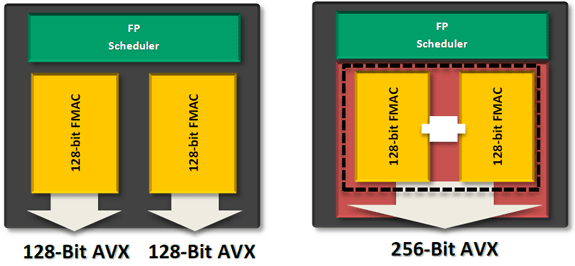
The problem is AMD had to increase the functionality of its FPU with the move to Bulldozer. The Phenom II architecture lacks SSE4 and AVX support, both of which were added in Bulldozer. Furthermore, AMD chose Bulldozer as the architecture to include support for fused multiply-add instructions (FMA). Enabling FMA support also increases the relative die area of the FPU. So while the throughput of Bulldozer's FPU hasn't increased over K8, its capabilities have. Unfortunately this means that peak FP throughput running x87/SSE2/3 workloads remains unchanged compared to the previous generation. Bulldozer will only be faster if newer SSE, AVX or FMA instructions are used, or if its clock speed is significantly higher than Phenom II.
Looking at our Cinebench 11.5 multithreaded workload we see the perfect example of this performance shuffle:
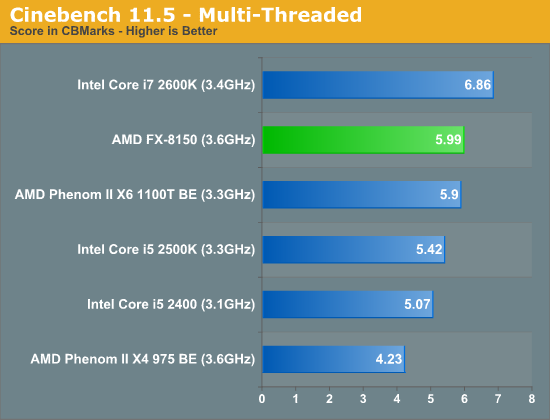
Despite a 9% higher base clock speed (more if you include turbo core), a 3.6GHz 8-core Bulldozer is only able to outperform a 3.3GHz 6-core Phenom II by less than 2%. Heavily threaded floating point workloads may not see huge gains on Bulldozer compared to their 6-core predecessors.
There's another issue. Bulldozer, at least at launch, won't have to simply outperform its quad-core predecessor. It will need to do better than a six-core Phenom II. In this comparison unfortunately, the Phenom II has the definite throughput advantage. The Phenom II X6 can execute 50% more SSE2/3 and x87 FP instructions than a Bulldozer based FX.
Since the release of the Phenom II X6, AMD's major advantage has been in heavily threaded workloads—particularly floating point workloads thanks to the sheer number of resources available per chip. Bulldozer actually takes a step back in this regard and as a result, you will see some of those same workloads perform worse, if not the same as the outgoing Phenom II X6.
Compared to Sandy Bridge, Bulldozer only has two advantages in FP performance: FMA support and higher 128-bit AVX throughput. There's very little code available today that uses AMD's FMA instruction, while the 128-bit AVX advantage is tangible.
Cache Hierarchy and Memory Subsystem
Each integer core features its own dedicated L1 data cache. The shared FP core sends loads/stores through either of the integer cores, similar to how it works in Phenom II although there are two integer cores to deal with now instead of just one. Bulldozer enables fully out-of-order loads and stores, an improvement over Phenom II putting it on parity with current Intel architectures. The L1 instruction cache is shared by the entire bulldozer module, as is the L2 cache.
The instruction cache is a large 64KB 2-way set associative cache, similar in size to the Phenom II's L1 cache but obviously shared by more "cores". A four-core Phenom II would have 256KB of total L1 I-Cache, while a four core Bulldozer will have half of that. The L1 data caches are also significantly smaller than Bulldozer's predecessor. While Phenom II offered a 64KB L1 D-Cache per core, Bulldozer only offers 16KB per integer core.
The L2 cache is much larger than what we saw in multi-core Phenom II designs however. Each Bulldozer module has a private 2MB L2 cache.
There's a single 8MB L3 cache that's shared among all Bulldozer modules on a chip. In its first incarnation, AMD has no plans to offer a desktop part without an L3 cache. However AMD indicated that the L3 cache was only really useful in server workloads and we might expect future Bulldozer derivatives (ahem, Trinity?) to forgo the L3 cache entirely as a result.

Cache accesses require more clocks in Bulldozer, due to a combination of size and AMD's desire to make Bulldozer a very high clock speed part...



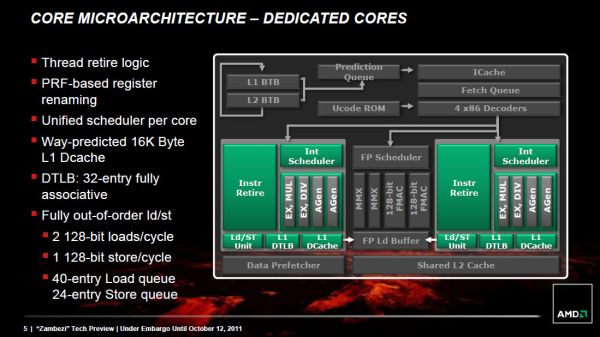
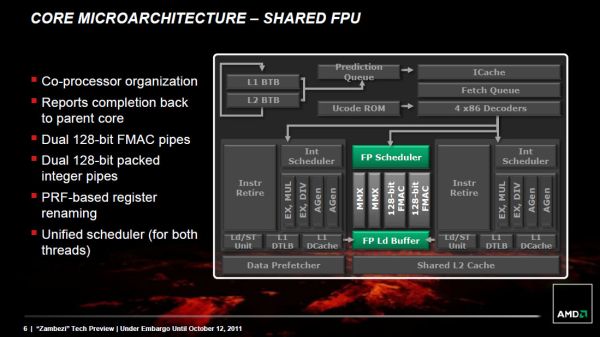
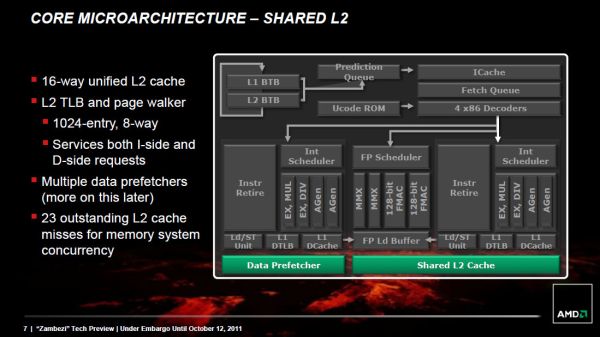








430 Comments
View All Comments
Shuxclams - Wednesday, October 12, 2011 - link
Wow... I mean what else do you say? Intel is walking away from the competition, and thats sucks for everyone long term. FAILezinner - Wednesday, October 12, 2011 - link
AMD, please up your game. Stop being just the lower price point and become the leader. We do not need 10 to 20 processors to choose from. Let's have less products and better performance, even if the price is the same or more than Intel. I like that you stick with the socket longer than Intel, but you keep getting beat everytime. AMD needs new people who can drive them further ahead.BlueFlash - Wednesday, October 12, 2011 - link
New architectures always require software optimization to shine. Will enough Bulldozers sell to convince major software vendors to do that work? Could we get some AMD optimized benchmarks? In any case, I prefer the APU strategy, given my compute needs.Chaser - Wednesday, October 12, 2011 - link
I invested in AMD last a while back and like many on here thought that BD was going to restore AMD's prominence as the enthusiast's definitive choice once again. Thankfully, especially now, I pulled out my money when it was still safe and also decided to not wait for my next upgrade rig and thankfully (now) I went Z68, I7 2500K and GTX 580.Maybe my hopes for AMD CPU wise was a pipe-dream. It just seems that INTEL is so far ahead of them now with their rather aggressive development that AMD is destined to be the bargain basement alternative forever. Regardless of my lack of realism or false hopes I suppose, its still a downer.
bji - Wednesday, October 12, 2011 - link
At a certain point in the not too distant future, the x86 market will be stagnant enough in terms of sales growth (with mobile devices taking larger and larger shares of the computing market) that it will not pay to spend the exponentially increasing R & D dollars to advance x86 state of the art. At that point, AMD will have an opportunity to catch up to Intel - if AMD survives in the x86 market long enough.FunBunny2 - Wednesday, October 12, 2011 - link
Always remember: no one, that's *no one* not even Intel, runs X86 instruction set in hardware. No one. All these X86 cpus emulate is instruction set through a RISC core. It's only a matter of time until nobody bothers with the emulation.Mishera - Wednesday, October 12, 2011 - link
Let me try to paint a glass half full picture:Amd's CPU division had to have known that the performance of this architecture for years now... So I imagine that this might not be just a "Let's just get something out there" move. So maybe there's some alternative ways of looking at this:
1. Amd has made it clear that this is the beginning of what they really mean by APU and there will be more architecture movement towards that end in the future. Could this be a transistion CPU to a possibly very different x86 future?
This may not be just what AMD is planning to do on it's own. There have been rumors of a possible Arm partnership.
http://semiaccurate.com/2011/06/22/amd-and-arm-joi...
Could it be that this chip has a better set up than phenom for an interchangeable modular structure?
2. With desktop pcs in decline could this be a move to capture more server space, which is still a growing market?
3. This obviously also begs the question is there some benefit of this design with a gpu attached?
4. Is there some benefit for mobile computing?(starting to stretch here...)
I don't know. I don't want to think this is just an epic fail but...
This is kind of sad since I was betting they'd be 3/3 but on the really big one the shot out a dud.
fic2 - Wednesday, October 12, 2011 - link
Kind of wondering about #3.Let the wait for Trinity begin. Hopefully the changes from Bulldozer->Piledriver help more than is expected.
If the FM1 platform wasn't dead I would think about getting a Llano desktop for my nephew but I think he'll just have to wait. Maybe if FM2 mb start coming out and Llano can drop in with a possible change to Trinity later.
Mishera - Thursday, October 13, 2011 - link
Yeah, I think I meant #3 to be part of #4. I cant help but to think that is bulldozer performs poorly in a trinity package that's very bad news for Amd, even if this performs well in servers..I am left wondering how much of bulldozer as an architecture is an evolutionary step to the future they've described. I think that's much more important than the performance we see today. Perhaps this could in that respect be a Fermi and not so much Pentium 4.
tipoo - Wednesday, October 12, 2011 - link
Their own last generation 6 core Thuban beats this in half the tasks. If you have an application that effectively uses 8 threads, this might be a worthy upgrade, but anything lightly threaded is pretty bad (looking at the real world benchmarks, Techreport, Anandtech, Tomshardware, etc). I had high hopes for this.They did say though that Windows 8 would make better use of modules (vs cores) and will know what to do with them better, and to expect another 10% increase from that. But we're still at a point where an AMD core doesn't even beat out a Nehalem core, let alone a Sandy Bridge or Ivy Bridge.
*Le Sigh*
This Bulldozer is more of a Mudshovel. Their goal of 15% single threaded performance increase per core per year won't have them catching up to Intel anytime soon either.
Well, the optimist in me says the L3 cache-less higher clocked quad core mainstream parts will be more competitive. And cheap too, the 6 core FX is only 169.